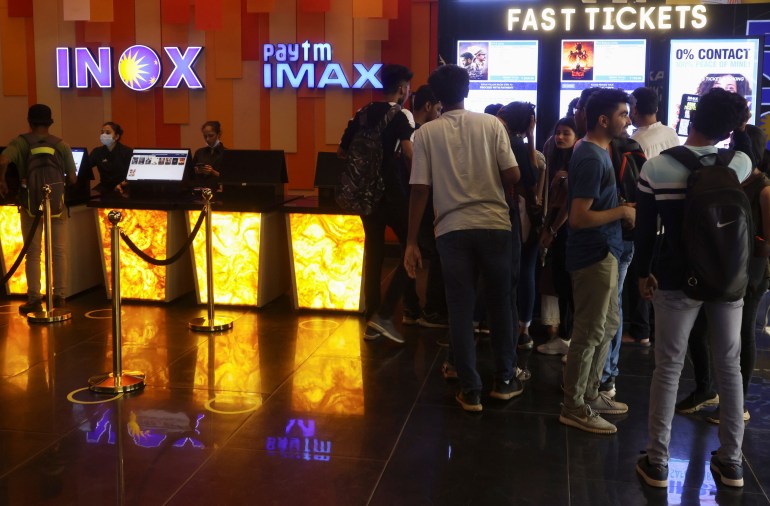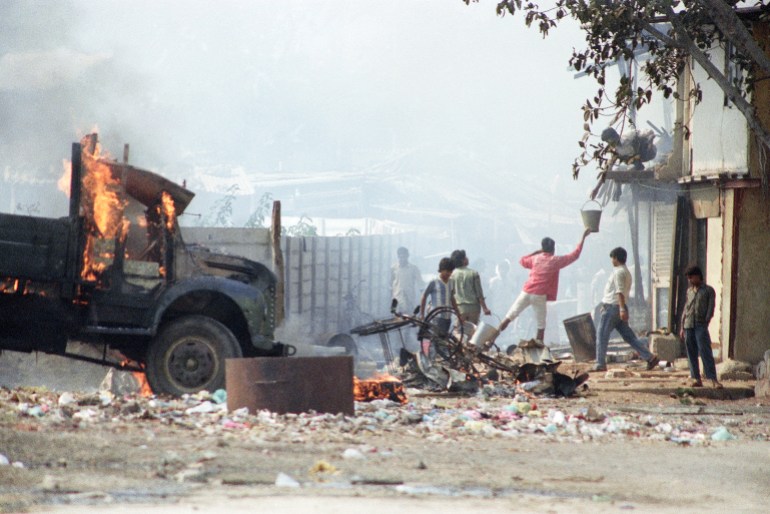
Yavatmal/Mumbai, India – For a month, mini-trucks have been winding through labyrinthine streets through villages in the Yavatmal district of central India.
Yavatmal is so badly affected by agricultural distress that more than 5,800 farmers here have committed suicide in the last two decades, according to local municipality data.
But these trucks have brought no help to the distressed farmers. Instead, the trucks roamed deep through the district with a photo of the Hindu god Ram on posters on the sides, urging farmers to donate grain.
The grains will be brought to Ayodhya to feed hundreds of thousands of devotees visiting the city where Prime Minister Narendra Modi will be present dedicate a temple to Ram on January 22, more than three decades after a mob led by Hindu nationalists demolished a mosque that stood at the site.
The trucks are operated by the Vishwa Hindu Parishad (VHP), part of the Hindu nationalist Sangh Parivar network led by the Rashtriya Swayamsevak Sangh (RSS), which also includes Modi’s Bharatiya Janata Party (BJP).
At Yavatmal’s Samvidhan Chowk, workers hurriedly load a large container truck with sacks of grains. “We managed to fill three container trucks with these donations and this is the fourth,” says Raju Niwal, president of VHP Vidarbha Prant. The idea, say local VHP volunteers, is to mobilize farmers and make them feel involved in the celebrations.
It is a feeling that the Modi government and its ideological allies have successfully evoked across the country.
The movement to build the Ram temple in Ayodhya, the place where he is believed to have been born according to Hindu scriptures, was surrounded by violence and bitter conflict. Almost 2,500 people (PDF)According to a research report by the Institute of Peace and Conflict Studies, people were killed during the violence that erupted in the early 1990s over the BJP-led agitation for a Ram temple.
But as Modi prepares to inaugurate the Ram Temple, the country is awash in popular cultural acts and symbols that ignore this troubled past, giving the Ram Temple movement a benevolent image and leaving a lasting legacy for Modi among Hindus , say analysts.
Pop songs and popcorn
From social media chronicles to schools, the temple inauguration is everywhere. Music platforms are abuzz with a spate of new songs urging citizens to celebrate the occasion and insisting that Ram is “coming back”. New television shows have emerged based around Ram’s life. Reality TV shows have dedicated entire episodes to songs celebrating Ram and built a makeshift temple in the studio. Huge Ram stickers can be seen on news television station vehicles, while news studios feature large cutouts of Ram as a backdrop for news debates. India’s largest domestic airline, Indigo, had its cabin crew dress up as Ram, wife Sita and brother Lakshman on its inaugural flight from Ahmedabad to Ayodhya.
On Friday, PVR Cinemas, one of India’s largest cinema chains, announced that it will, in collaboration with leading Hindi news channel Aaj Tak, broadcast live footage of the temple’s inauguration ceremony in cinema halls across the country, with “a free prize.” Combo” for the participants.
On WhatsApp and Instagram, Reels and videos celebrate the inauguration of the temple with vivid images – one image that is going viral across platforms shows Modi towering over Ram and leading him into the temple.
Modi has approved most of it – an analysis of his Twitter timeline shows he has tweeted at least 16 songs related to Ram this month. He even created a playlist of 62 such songs, which he tweeted on Friday. Of the 14 posts on his WhatsApp channel since January 1, at least five have been about the inauguration of the Ram Temple.
Inspired, several top-class singers have released songs related to the event in the last few weeks – from Sonu Nigam, Jubin Nautiyal, Shaan, Udit Narayan, Alka Yagnik and Kailash Kher to music composers Amit Trivedi and Anu Malik. Many of these music videos contain images of Modi. These songs were repurposed into crowd-created reels and videos, increasing their reach manifold.
But many say what’s missing from the euphoria is an acknowledgment of the movement’s bloody past surrounding the temple.
1947 again?
Author Nilanjan Mukhopadhyay, who covered the furor that led to the demolition of the 16th-century Babri Mosque in Ayodhya, says the celebrations echo the events of August 15, 1947. At the same time, India was celebrating its independence from Britain Colonial rule At that time, large parts of the country sank into interreligious hatred and the subcontinent was divided into two parts.
“Striking parallels can be drawn between January 22 and August 15, 1947, not with the celebrations surrounding India’s independence, but with the tragedies surrounding its partition [into India and Pakistan]says Mukhopadhyay, author of the 1994 book The Demolition: India at the Crossroads.
Mukhopadhyay recalls a recent conversation with a Muslim friend who told him how Muslims exchanged messages warning each other not to take public transport on January 22 or not to flaunt their Muslim identities on that day .
“On the other hand, the victorious Hindu enjoys this fear. There is a sense of collective triumph for many,” he says.
However, none of this fear and disappointment is reflected in the public discourse surrounding the inauguration.

The young identity
What this reflects is the triumphalism that Mukhopadhyay mentions – in some cities, pregnant women have reportedly asked for their deliveries to coincide with the inauguration. The Bar Council of India has written to Supreme Court Chief Justice DY Chandrachud requesting that all courts across the country be closed on January 22 to allow lawyers and legal staff to take part in the celebrations around the temple. The exchange will remain closed on Monday and will instead operate on January 20, a Saturday, to catch up on trading hours.
Many believe such celebrations are intended for India’s young population – half of the country is under 25, and was founded almost a decade after the violence and deaths associated with the Babri Mosque agitation and demolition.
“Today’s youth don’t know anything about Babri Mosque. They have never been told anything about the history of this issue and hence demolition is not part of their imagination at all,” says sociologist Nandini Sardesai. Pointing to the abundance of songs and television content surrounding the event, Sardesai says: “Religion is no longer an institution, it has become a part of popular culture.” Therefore, today everything – from music to dance to films – has an element of it Religion.”
According to a news report, in Mumbai, BJP minister Mangal Prabhat Lodha asked public school students to write essays, poems, plays and sketches on Ram. The Modi government is airing a special series of Ram-related stories on state broadcaster Doordarshan in the run-up to the inauguration, among other programs related to the event. In fact, the Modi government even gave half a day leave to all central government employees on Inauguration Day. Five regional governments, all controlled by the BJP, have declared Monday a public holiday and some have even banned the sale of liquor on the day.

A persistent pain
For Mumbai resident Abdul Wahid Shaikh, 44, all these celebrations are harrowing and a reminder of a pain that lives on.
Around him, many streets in Mumbai are decorated with saffron flags and large ram figures. New Year greetings with pictures of Ram can be seen on billboards.
Shaikh, a resident of East Mumbai, was just 13 years old when he saw the embers of hatred engulf his area after the Babri Mosque was demolished. In the days that followed, rioters from right-wing Hindu parties attacked Muslim homes in his neighborhood. “Muslims lived under self-imposed curfews back then,” he said.
The violence, Shaikh said, appeared to have been deliberately forgotten without any attempt to close the case. “When the government is on your side, even a crime becomes a celebration,” he said.
The fear he felt back then has not gone away. “As January 22 approaches, many Muslims are talking to each other about staying at home on this day and not engaging in provocations from Hindu nationalists,” he added.
For many Muslims like Sheikh, January 22 will once again be a self-imposed curfew.






Recent Comments